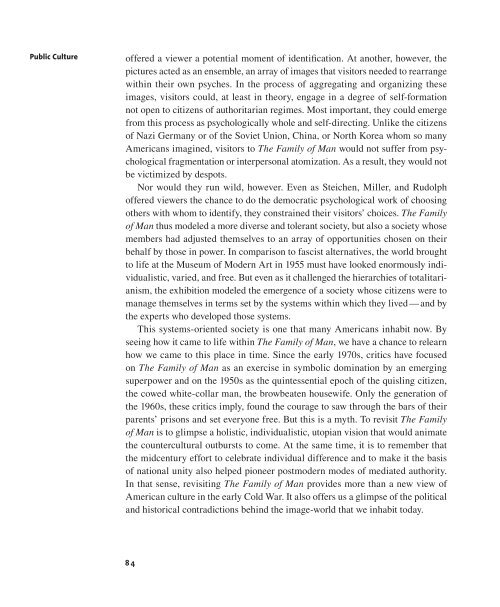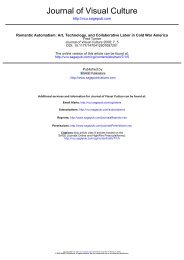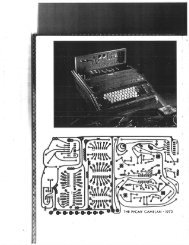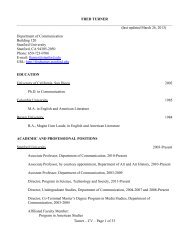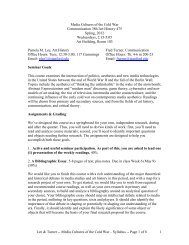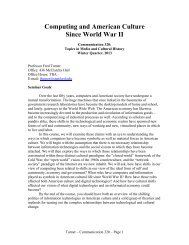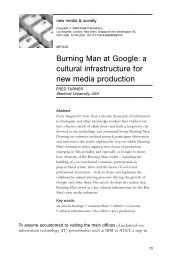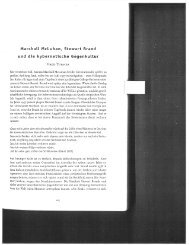The Family of Man and the Politics of Attention in ... - Public Culture
The Family of Man and the Politics of Attention in ... - Public Culture
The Family of Man and the Politics of Attention in ... - Public Culture
Create successful ePaper yourself
Turn your PDF publications into a flip-book with our unique Google optimized e-Paper software.
<strong>Public</strong> <strong>Culture</strong><br />
<strong>of</strong>fered a viewer a potential moment <strong>of</strong> identification. At ano<strong>the</strong>r, however, <strong>the</strong><br />
pictures acted as an ensemble, an array <strong>of</strong> images that visitors needed to rearrange<br />
with<strong>in</strong> <strong>the</strong>ir own psyches. In <strong>the</strong> process <strong>of</strong> aggregat<strong>in</strong>g <strong>and</strong> organiz<strong>in</strong>g <strong>the</strong>se<br />
images, visitors could, at least <strong>in</strong> <strong>the</strong>ory, engage <strong>in</strong> a degree <strong>of</strong> self- formation<br />
not open to citizens <strong>of</strong> authoritarian regimes. Most important, <strong>the</strong>y could emerge<br />
from this process as psychologically whole <strong>and</strong> self- direct<strong>in</strong>g. Unlike <strong>the</strong> citizens<br />
<strong>of</strong> Nazi Germany or <strong>of</strong> <strong>the</strong> Soviet Union, Ch<strong>in</strong>a, or North Korea whom so many<br />
Americans imag<strong>in</strong>ed, visitors to <strong>The</strong> <strong>Family</strong> <strong>of</strong> <strong>Man</strong> would not suffer from psychological<br />
fragmentation or <strong>in</strong>terpersonal atomization. As a result, <strong>the</strong>y would not<br />
be victimized by despots.<br />
Nor would <strong>the</strong>y run wild, however. Even as Steichen, Miller, <strong>and</strong> Rudolph<br />
<strong>of</strong>fered viewers <strong>the</strong> chance to do <strong>the</strong> democratic psychological work <strong>of</strong> choos<strong>in</strong>g<br />
o<strong>the</strong>rs with whom to identify, <strong>the</strong>y constra<strong>in</strong>ed <strong>the</strong>ir visitors’ choices. <strong>The</strong> <strong>Family</strong><br />
<strong>of</strong> <strong>Man</strong> thus modeled a more diverse <strong>and</strong> tolerant society, but also a society whose<br />
members had adjusted <strong>the</strong>mselves to an array <strong>of</strong> opportunities chosen on <strong>the</strong>ir<br />
behalf by those <strong>in</strong> power. In comparison to fascist alternatives, <strong>the</strong> world brought<br />
to life at <strong>the</strong> Museum <strong>of</strong> Modern Art <strong>in</strong> 1955 must have looked enormously <strong>in</strong>dividualistic,<br />
varied, <strong>and</strong> free. But even as it challenged <strong>the</strong> hierarchies <strong>of</strong> totalitarianism,<br />
<strong>the</strong> exhibition modeled <strong>the</strong> emergence <strong>of</strong> a society whose citizens were to<br />
manage <strong>the</strong>mselves <strong>in</strong> terms set by <strong>the</strong> systems with<strong>in</strong> which <strong>the</strong>y lived — <strong>and</strong> by<br />
<strong>the</strong> experts who developed those systems.<br />
This systems- oriented society is one that many Americans <strong>in</strong>habit now. By<br />
see<strong>in</strong>g how it came to life with<strong>in</strong> <strong>The</strong> <strong>Family</strong> <strong>of</strong> <strong>Man</strong>, we have a chance to relearn<br />
how we came to this place <strong>in</strong> time. S<strong>in</strong>ce <strong>the</strong> early 1970s, critics have focused<br />
on <strong>The</strong> <strong>Family</strong> <strong>of</strong> <strong>Man</strong> as an exercise <strong>in</strong> symbolic dom<strong>in</strong>ation by an emerg<strong>in</strong>g<br />
superpower <strong>and</strong> on <strong>the</strong> 1950s as <strong>the</strong> qu<strong>in</strong>tessential epoch <strong>of</strong> <strong>the</strong> quisl<strong>in</strong>g citizen,<br />
<strong>the</strong> cowed white- collar man, <strong>the</strong> browbeaten housewife. Only <strong>the</strong> generation <strong>of</strong><br />
<strong>the</strong> 1960s, <strong>the</strong>se critics imply, found <strong>the</strong> courage to saw through <strong>the</strong> bars <strong>of</strong> <strong>the</strong>ir<br />
parents’ prisons <strong>and</strong> set everyone free. But this is a myth. To revisit <strong>The</strong> <strong>Family</strong><br />
<strong>of</strong> <strong>Man</strong> is to glimpse a holistic, <strong>in</strong>dividualistic, utopian vision that would animate<br />
<strong>the</strong> countercultural outbursts to come. At <strong>the</strong> same time, it is to remember that<br />
<strong>the</strong> midcentury effort to celebrate <strong>in</strong>dividual difference <strong>and</strong> to make it <strong>the</strong> basis<br />
<strong>of</strong> national unity also helped pioneer postmodern modes <strong>of</strong> mediated authority.<br />
In that sense, revisit<strong>in</strong>g <strong>The</strong> <strong>Family</strong> <strong>of</strong> <strong>Man</strong> provides more than a new view <strong>of</strong><br />
American culture <strong>in</strong> <strong>the</strong> early Cold War. It also <strong>of</strong>fers us a glimpse <strong>of</strong> <strong>the</strong> political<br />
<strong>and</strong> historical contradictions beh<strong>in</strong>d <strong>the</strong> image- world that we <strong>in</strong>habit today.<br />
84


